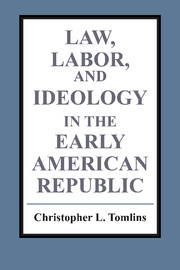Book contents
- Frontmatter
- Contents
- Preface and acknowledgments
- Prologue: two moments of the republic
- PART 1 LAW AND THE FACTS OF AMERICAN LIFE
- PART 2 LAW, LABOR, AND STATE
- PART 3 LAW, AUTHORITY, AND THE EMPLOYMENT RELATIONSHIP
- Introduction: the nomenclature of power
- 7 The law of master and servant
- 8 Master and servant in republican America
- An interlude: on law and economy
- PART 4 THE NEW INDUSTRIAL ORDER
- Epilogue: “free Ameriky”
- Index
Introduction: the nomenclature of power
Published online by Cambridge University Press: 05 August 2012
- Frontmatter
- Contents
- Preface and acknowledgments
- Prologue: two moments of the republic
- PART 1 LAW AND THE FACTS OF AMERICAN LIFE
- PART 2 LAW, LABOR, AND STATE
- PART 3 LAW, AUTHORITY, AND THE EMPLOYMENT RELATIONSHIP
- Introduction: the nomenclature of power
- 7 The law of master and servant
- 8 Master and servant in republican America
- An interlude: on law and economy
- PART 4 THE NEW INDUSTRIAL ORDER
- Epilogue: “free Ameriky”
- Index
Summary
“There is no such relation as master and servant in the United States,” observed a British-born attorney, John Bristed, in 1818. “Indeed, the name is not permitted: – ‘help’ is the designation of one who condescends to receive wages for service.” His was no isolated impression. Commentators on the society of the early nineteenth-century United States commonly used the antipathy of working people toward the language of servitude to impress on their readers the depth of antagonism toward the accoutrements of traditional society which they had found in the new republic. Charles W. Janson, whose The Stranger in America dwelt on “the arrogance of domestics in this land of republican liberty and equality,” reported the following conversation with a “servant-maid” who had opened the door to his knock on a visit to an acquaintance:
Is your Master at home? – I have no Master.
Don't you live here? – I stay here.
And who are you then? – Why, I am Mr. — 's help. I'd have you to know, man, that I am no sarvant. None but negers are sarvants.
In 1805 the self-styled “working shoemakers” of Philadelphia had roundly condemned their “masters” for their adoption of “the slavish style of Europe.”
- Type
- Chapter
- Information
- Law, Labor, and Ideology in the Early American Republic , pp. 223 - 231Publisher: Cambridge University PressPrint publication year: 1993



